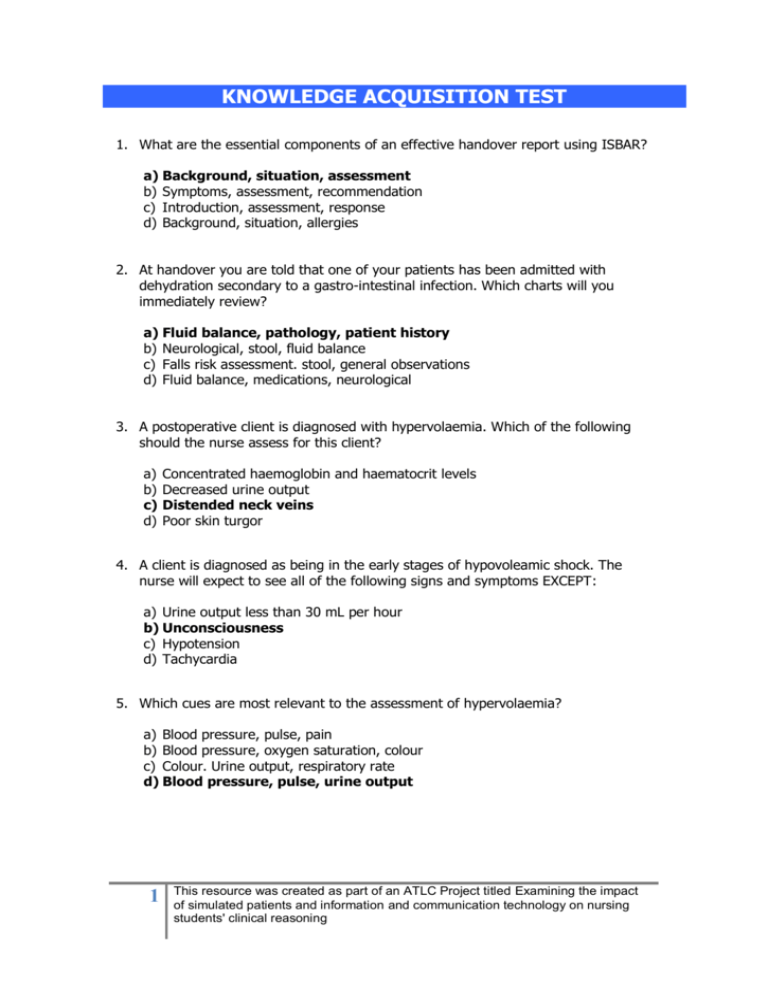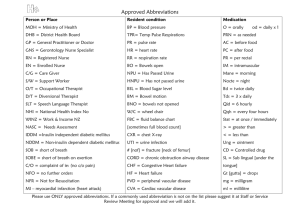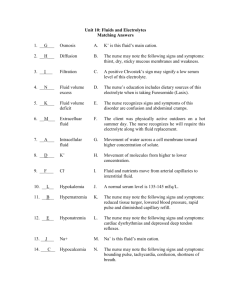KNOWLEDGE ACQUISITION TEST
advertisement

KNOWLEDGE ACQUISITION TEST 1. What are the essential components of an effective handover report using ISBAR? a) Background, situation, assessment b) Symptoms, assessment, recommendation c) Introduction, assessment, response d) Background, situation, allergies 2. At handover you are told that one of your patients has been admitted with dehydration secondary to a gastro-intestinal infection. Which charts will you immediately review? a) Fluid balance, pathology, patient history b) Neurological, stool, fluid balance c) Falls risk assessment. stool, general observations d) Fluid balance, medications, neurological 3. A postoperative client is diagnosed with hypervolaemia. Which of the following should the nurse assess for this client? a) b) c) d) Concentrated haemoglobin and haematocrit levels Decreased urine output Distended neck veins Poor skin turgor 4. A client is diagnosed as being in the early stages of hypovoleamic shock. The nurse will expect to see all of the following signs and symptoms EXCEPT: a) Urine output less than 30 mL per hour b) Unconsciousness c) Hypotension d) Tachycardia 5. Which cues are most relevant to the assessment of hypervolaemia? a) Blood pressure, pulse, pain b) Blood pressure, oxygen saturation, colour c) Colour. Urine output, respiratory rate d) Blood pressure, pulse, urine output 1 This resource was created as part of an ATLC Project titled Examining the impact of simulated patients and information and communication technology on nursing students' clinical reasoning 6. Identify which of the following is not a true statement: a) Oliguria can be caused by hypotension b) Hypertensive can be caused by excessive IV fluids. c) Third space fluid shift can cause tachycardia d) Pre- operative bowel preps can cause hypervoleamia 7. A client is prescribed 20 mmol of potassium chloride. The nurse realises that the client is receiving this replacement: a) To keep a vein open. b) To help regulate electrolyte balance. c) To encourage urine output. d) To sustain respiratory function. 8. The nurse is implementing a plan of care for a client. After providing care, what should the nurse do as the final step in the process? a) b) c) d) Nothing Reassess the client. Document Give the charge nurse a report. 9. An elderly client is being assessed and the nurse notes that the client's carbon dioxide level is elevated. Which of the following nursing interventions would be indicated for this client? a) b) c) d) Monitor intake and output. Monitor respiratory status and oxygen saturation levels. Monitor serum sodium level. Monitor serum potassium level. 10. Which of the following is NOT an accurate statement? a) frusemide is indicated for severe sodium and fluid depletion b) frusemide inhibits reabsorption of sodium and chloride in the ascending limb of the loop of Henle c) frusemide produces a rapid diuresis and has a short duration of action d) frusemide may cause tinnitus, vertigo and deafness if infused rapidly 2 This resource was created as part of an ATLC Project titled Examining the impact of simulated patients and information and communication technology on nursing students' clinical reasoning 11. When the inflammatory stage of wound healing resolves (24-48 hours post operatively), what are the possible consequences for your patients’ fluid status? Which of the following is incorrect? a) Plasma from the interstitial compartment typically returns to the circulating blood volume b) Plasma from the intravascular compartment typically returns to the intracellular compartment c) Significant increases in blood volume add to the likelihood of hypervolaemia. d) The third space fluid shift resolves resulting in increased blood volume. 12. Fluid shifts can contribute to tachypnoea because: (a) Hypovolaemia causes anxiety (b) Dehydration causes carbon dioxide retention (c) Insensible fluid losses cause hypoxia (d) Fluids shifts in the alveolar spaces can impact oxygenation levels 13. A normal oxygen saturation level for a post-operative patient is: a) 80-85% b) 85-90% c) 90-95% d) 95-100% 14. An acceptable urine output for an 90 year old 80Kg woman would be: a) 30-40 mls per hour b) 60-80 mls per hour c) 10-20 mls per hour d) 40-60 mls per hour 15. When a person’s glomerular filtration rate drops: (a) the anterior pituitary gland responds by secreting antidiuretic hormone (b) the adrenal glands respond by secreting renin (c) the adrenal glands respond by reducing the secretion of aldosterone (d) the juxtoglomerular cells in the kidney respond by secreting renin 16. Antidiuretic hormone is secreted: (a) by the anterior pituitary gland in response to increased serum albumin (b) by the posterior pituitary gland in response to increased serum osmolality 3 This resource was created as part of an ATLC Project titled Examining the impact of simulated patients and information and communication technology on nursing students' clinical reasoning (c) by the posterior pituitary gland in response to decreased serum sodium levels (d) by the collecting ducts of the kidneys in response to dehydration 17. Oliguria: (a) may be defined as an absence of urine production (b) is common after major surgery, and as such, is nothing for the nurse to be concerned about (c) is generally defined as more than 30mls per hour of urine excretion and is uncommon in the immediate post-operative period (d) is generally defined as less than 30mls per hour of urine excretion and, left untreated, may lead to acute renal failure 18. When assessing a patient’s fluid status which of the following groups include the most important nursing observations: (a) weight, urine output, bowel sounds (b) Chvostek’s sign, fluid intake, blood pressure (c) serum potassium, bowel sounds, urine output (d) urine output, blood pressure, weight 19. Insensible fluid loss occurs through all of the following routes except: (a) skin (b) lungs (c) kidneys (d) gastrointestinal tract 20. In assessing a patient with dehydration, you would expect the urine output to be: (a) increased with elevated specific gravity (b) increased with decreased specific gravity (c) decreased with elevated specific gravity (d) decreased with decreased specific gravity 21. A third-space fluid shift may occur as a result of all of the following except: (a) hypoalbuminaemia (b) an allergic reaction (c) hypertension (d) hypovolaemia 4 This resource was created as part of an ATLC Project titled Examining the impact of simulated patients and information and communication technology on nursing students' clinical reasoning







